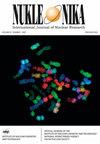Numerical studies of plasma edge in W7-X with 3D FINDIF code
IF 0.3
4区 物理与天体物理
Q4 CHEMISTRY, INORGANIC & NUCLEAR
引用次数: 0
Abstract
Abstract Modelling of the plasma transport for inherently three-dimensional (3D) problems as in stellarators requires dedicated complex codes. FINDIF is a 3D multifluid plasma edge transport code that has been previously successfully used for the analysis of energy transport in the TEXTOR-DED tokamak [1], where 3D perturbations led to an ergodic structure of field lines in the plasma edge. The ongoing efforts to apply it meaningfully to Wendelstein 7-X (W7-X) plasma problems resulted in advancements in the main model and accompanying tools for mesh generation and post-processing. In order to verify the applicability of the code and to compare with the reported simulation (EMC3-EIRENE) and experimental (OP1.1) results, a series of simulations for varying plasma density, temperature and anomalous transport coefficients as well as for fixed input power were performed. The connection length pattern of FINDIF traced magnetic field lines on the limiter was reproduced and its impact on heat loads was confirmed. An increase in the peak heat load on the limiter with a rise in plasma density, temperature and anomalous plasma transport coefficients was observed. The decay lengths of density, electron temperature and heat flux did not change with density, and were decreasing with temperature and increasing with anomalous plasma transport coefficient, which was compared to the simple scrape-off layer (SOL) model.W7-X等离子体边缘的三维FINDIF数值研究
仿星器等固有三维(3D)问题的等离子体输运建模需要专用的复杂代码。FINDIF是一种三维多流体等离子体边缘输运代码,之前已成功用于分析TEXTOR-DED托卡马克中的能量输运[1],其中三维扰动导致等离子体边缘场线的遍历结构。将其有意义地应用于Wendelstein 7-X (W7-X)等离子体问题的持续努力导致了主要模型和网格生成和后处理配套工具的进步。为了验证代码的适用性,并与已报道的仿真(EMC3-EIRENE)和实验(OP1.1)结果进行比较,对不同等离子体密度、温度和异常输运系数以及固定输入功率进行了一系列模拟。再现了FINDIF跟踪磁力线在限位器上的连接长度模式,并证实了其对热负荷的影响。限制器上的峰值热负荷随着等离子体密度、温度和异常等离子体输运系数的升高而增加。与简单刮擦层(SOL)模型相比,密度、电子温度和热流密度的衰减长度不随密度的变化而变化,而是随温度的升高而减小,随异常等离子体输运系数的增大而增大。
本文章由计算机程序翻译,如有差异,请以英文原文为准。
求助全文
约1分钟内获得全文
求助全文
来源期刊

Nukleonika
物理-无机化学与核化学
CiteScore
2.00
自引率
0.00%
发文量
5
审稿时长
4-8 weeks
期刊介绍:
"Nukleonika" is an international peer-reviewed, scientific journal publishing original top quality papers on fundamental, experimental, applied and theoretical aspects of nuclear sciences.
The fields of research include:
radiochemistry, radiation measurements, application of radionuclides in various branches of science and technology, chemistry of f-block elements, radiation chemistry, radiation physics, activation analysis, nuclear medicine, radiobiology, radiation safety, nuclear industrial electronics, environmental protection, radioactive wastes, nuclear technologies in material and process engineering, radioisotope diagnostic methods of engineering objects, nuclear physics, nuclear reactors and nuclear power, reactor physics, nuclear safety, fuel cycle, reactor calculations, nuclear chemical engineering, nuclear fusion, plasma physics etc.
 求助内容:
求助内容: 应助结果提醒方式:
应助结果提醒方式:


